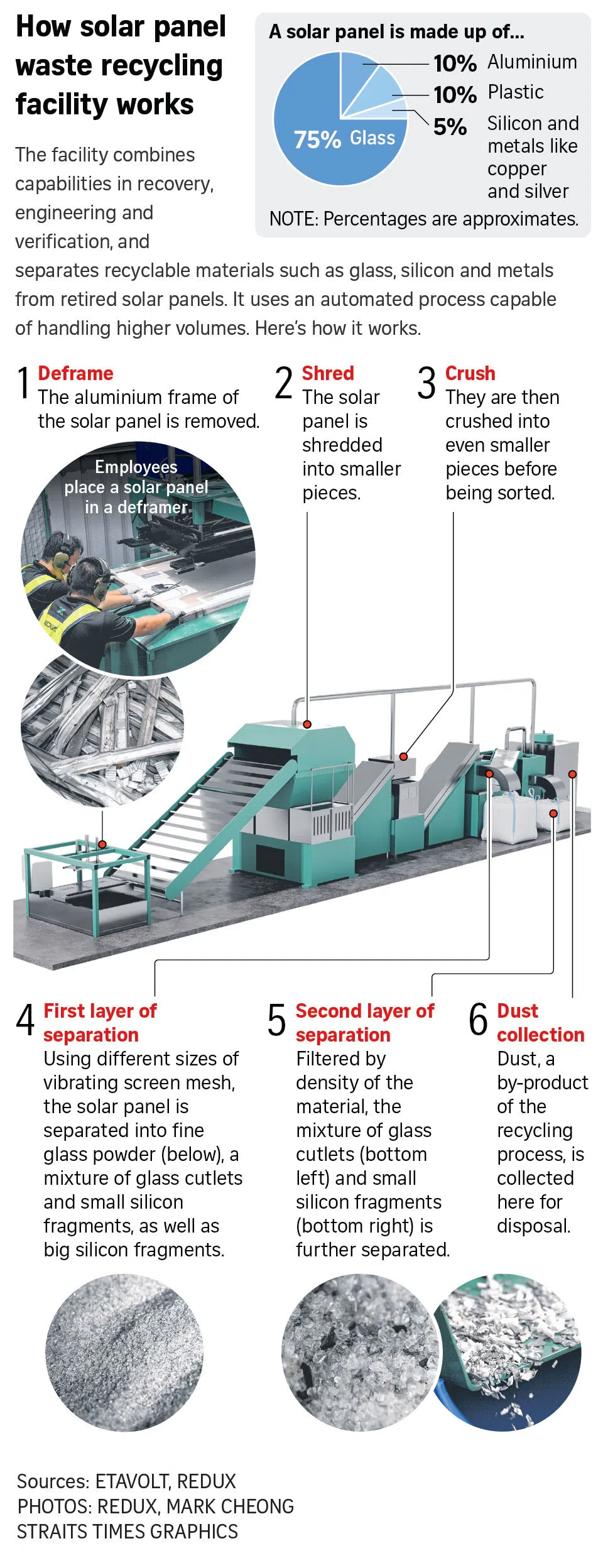New solar panel recycling facility in Singapore can process 36,000 panels a year
Sign up now: Get ST's newsletters delivered to your inbox

The facility aims to recover, recycle and reuse as much as 96 per cent of each solar panel.
ST PHOTO: MARK CHEONG
Follow topic:
SINGAPORE - Locally based recycling company Redux launched an automated solar panel recycling facility on Nov 24, as solar panel waste in the Republic is expected to increase, with older units becoming obsolete or reaching the end of their lifespan.
Located in Tuas, the facility aims to recover, recycle and reuse as much as 96 per cent of each solar panel, instead of sending them to the landfill, which is how such waste is currently being handled.
The process also helps to avoid up to 1,400 tonnes of carbon emissions, compared with sending the panels to the landfill.
The advanced technology solar e-waste facility is able to dismantle and process 18 solar panels in an hour, or 36,000 in a year – which is about 27 per cent of Singapore’s current solar panel waste, said Redux founder and business development director Jeff Seah.
According to Redux, the number of solar panels to be decommissioned in Singapore in a year is estimated to grow from 134,305 in 2025 to 157,087 in 2030.

Aluminium frames salvaged as part of solar panel recycling at Redux's automated solar panel recycling facility.
ST PHOTO: MARK CHEONG
Mr Seah said that this is because solar panels from the first wave of installations, which used older technology, have degraded over the years and are being decommissioned, a process that includes uninstalling and dismantling the panels.
Solar panels usually have a lifespan of between 20 and 30 years.
“If we don’t have a solution for them, they are going to the landfill,” Mr Seah said.
The project is a collaboration between Redux, tech start-up EtaVolt and green energy management solutions provider Vector Green.
EtaVolt, a spin-off from Nanyang Technological University, developed the technology to recycle solar panels, while Vector Green manages the decommissioning of solar panels.
EtaVolt’s founder and chief executive Stanley Wang said that the majority of the older type of solar panels globally are experiencing degradation to different degrees.
Some solar panels are also replaced before they reach the end of their lifespan, as newer panels are cheaper, more efficient and can generate more power, he added.
The facility, which runs on solar power, uses 1.14kWh of electricity to separate recyclable materials such as glass, silicon and metals from each solar panel.
Recovered materials are then sent to recycling plants for subsequent processing.
“By recovering materials that can be reused within the industry, we strengthen the circular economy and reduce the environmental footprint of solar adoption,” said Dr Wang.
Solar power remains Singapore’s most viable renewable energy option, with the country on track to achieving its ambition of at least two gigawatt-peak (GWp) of installed capacity before 2030. It currently has over 1.7 GWp of installed capacity.
According to the Energy Market Authority’s website, the installed capacity of solar panels increased from 1.193 GWp in 2023 to 1.573 GWp in 2024.
By 2050, solar is estimated to supply up to 10 per cent of Singapore’s projected electricity demand.
Speaking at the launch of the facility, Ms Low Yen Ling, Senior Minister of State for Trade and Industry, said that as solar deployment expands, more panels will need to be replaced with newer and more efficient models.
“This will lead to a growing volume of retired panels, both in Singapore and globally,” she said. “For a land-scarce Singapore, sending more solar waste to Semakau Landfill is not a sustainable option.”
To ensure sustainable deployment of solar panels across the island, Singapore must build capabilities that suit its dense and tropical environment, Ms Low said.
These include improving how it deploys and maintains solar systems, investing in energy storage, and managing solar panels responsibly at the end of their life cycle, she said.
Such innovation in recycling solar waste not only helps to reduce the amount of solar waste and helps firms to lower life-cycle emissions, but also contributes to Singapore’s national goal of reducing waste to landfill per capita per day by 30 per cent by 2030, she added.



